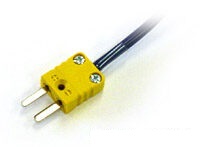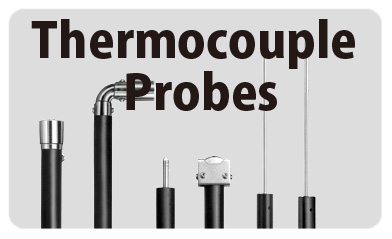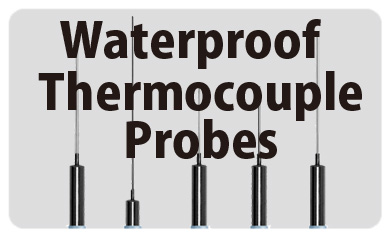Q1. What is a thermocouple?
A1. When you connect tips of two dissimilar metals and if there is a temperature difference between both ends, there occurs a thermal electromotive force.
This is called the Seebeck effect, and it is Thermocouple Thermometer that utilizes the effect to measure temperatures.
※Please refer to the article Temperature Sensors for further information.
Q2. What is a Sheathed thermocouple ?
A2. Thermocouples are usually insulated and placed in a protective tube with a handle or a connector. We refer to this type of thermocouple products as Pipe type.
Sheath type, on the other hand, is made by insulating the protective tube and thermocouple wires with magnesium oxide, which makes it possible to make a strong and ultra-fine thermocouple.
Pipe type shall be broken if bent, while Sheath type can be bent, thus providing durability.
Pipe type is less expensive and offers a lower measurement temperature range than Sheath type.
The tips of both types are sealed to prevent liquids from getting inside.
Q3. What is a compensating cable?
A3. A compensating cable is used as a leadwire to connect a thermocouple and a thermometer. Within operating temperature range, the cable compensates almost the same thermoelectromotive force as the thermocouple.
Q4. What kinds of thermocouples are there?
A4. There are B, R, S, K, E, J, T, and C as specified in JIS. Our thermocouple products are type K.
- Type K: With relatively large electromotive force, generally used for measurements from -200°C (-7.89mV) to 1200°C (+48.828mV).
It has good mechanical properties and is one of the most commonly used in industry.
Q5. How is responsiveness of thermocouples?
A5. It varies widely between models. For rod-shaped probes, the difference becomes significant.
Q6. What is the lifetime of a thermocouple?
A6. It depends on the way and temperature of use. A probe which can be used at several hundred degrees Celsius and last for several years may much shorten its service life if it is used around the temperature limit or not cleaned after acidic liquid measurement.
There may be also a difference in physical durability depending on how it is handled, so it is not necessarily appropriate to tell how long a thermocouple lasts.
Q7. How long can the probe be extended?
A7. Generally,it can be extended within a few meters. If it is extended beyond that, accuracy will be out of tolerance. Please use our extension cables which are sold separately.
Q8. Can probes be repaired?
A8. Basically, it is possible to repair probes. But it’s often less expensive to purchase a new one, depending on repair part and damage degree.
Although it is difficult to make a general statement since it depends on the usage conditions, you may as well take thermocouple probes as consumable items to be replaced regularly.
Q9. What shape is the tip of the stick probe of Line Seiki?
A9. The stick-shaped probes we sell on the Internet come in the following three shapes.
Please select the one that best suits your application.
| Rounded tip | Ideal for liquid application. Not suitable for internal temperature measurement of semi-solid objects. | |
| Pointed tip | Ideal for internal temperature measurement by piercing into semi-solid objects. It can also be used for liquid temperature measurement. | |
 | Bevelled tip | Suitable both for liquid and internal temperature measurement of semi-solid objects. |
Q10. What kind of connector is used?
A10. The connectors of our probes are of a type called “miniature connector”. This is a type of plug widely used for thermocouple probes in general.

Related Products



